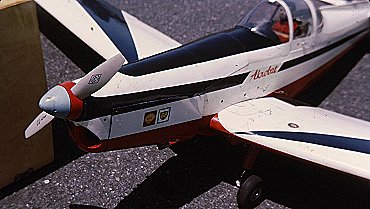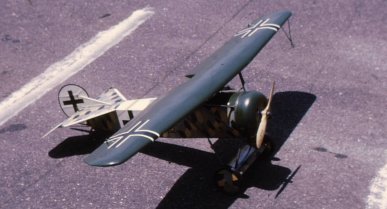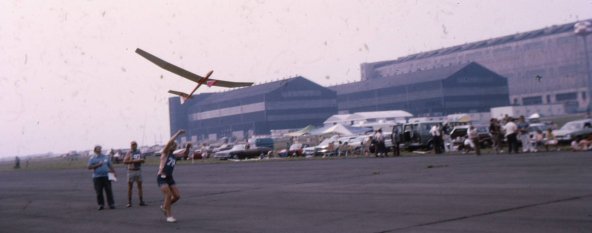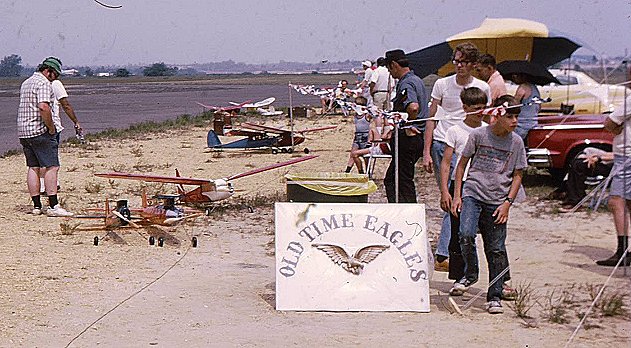
Gloom but not doom. Free-flight site. There's a model in there somewhere. Note the puddle.

Gloom but not doom. Free-flight site. There's a model in there somewhere. Note the puddle.
Individual and team events were won by Poland, the individual winner being Ryszard Czechowski. The British team managed ninth (John Blount), twelth (Laurie Barr) and fifteenth (Reg Parham). Their performances were down on their usual times because of the humidity (Aeromodeller described the air as 'like treacle'). I was not able to spend much time viewing this event (try watching a transparent model in low light anyway) but I did note that the Czech team manager was my old friend Josef Gabris, the greatest C/L stunt flyer of them all.
This particular building contained a number of artifacts which I tried to photograph. It was quite dim and I needed flash - which I didn't think to bring with me. Principal among these were two enormous gondola's from what must have been much larger versions of the familiar Goodyear blimp. Each contained two Pratt and Whitney 'Wasp' radial engines driving large propellers on outriggers via shafts with universal joints. They also had retractable undercarriages which seemed rather pointless.
The world championships for C/L scale had a full British team: Mick Reeves with his Zlin 'Akrobat' (3rd), my Wolves clubmate Ven Venables with his Fokker DVIII (8th) and Vic Willson with his DH 'Chipmunk' (12th). Micks Zlin was the 1970 world champion and was 8th in 1972.


In my own opinion, the standard of models here was generally low, with a few outstanding exceptions. One of the exceptions was a very ordinary looking twin engined russian airliner (Antonov An14M), built by Valery Kramarenko, with two very ingenius in-line 10cc glow motors made by team race world champion Boris Krasnorutski. This russian model had a host of working features and actually won the event.

Motor pictures and caption from 'Aeromodeller'.
|  |
While researching details for this page, I found that there was, apparently, a world championships for R/C Scale too but I have no pictures, or memories, of this other than seeing models in one of the workshop hangers. I have to assume that this took place during the evenings and clashed with the pylon event.
Having competed earlier in the first international meeting at Halton, I had an interest in the new 'triple task' F3B glider event (an open international meeting here like the pylon racing event) and paid for it by acting as tow-man for a couple of Sean Bannister's flights. In view of the heat and humidity I was actually amazed that I managed it! Sean's system was to instruct the tower to just keep running. He then hung onto the model until the line was stretched to its limit and then released the model which was literally catapulted into the sky.

Also a part of the proceedings was a Society of Antique Modellers (SAM) vintage free-flight meeting which I found fascinating. At this point the vintage movement was just gaining strength and was still largely unknown in the UK. Most of the models were large by UK standards, being designed for, and using, spark ignition (petrol) engines.

On one of the days, the four of us were driving across the 'drome towards the big hanger when there was a cry of, "What's THAT?", the car screeched to a halt and we all bailed out clutching our cameras. In the sky was a large cloud of what looked like silver spheres. We all took lots of pictures and pointed the cloud out to several locals. They explained that this was lenticular cloud and was a common phenomenon. We had to believe them, but I must admit I was not totally convinced. Particularly as my pictures refuse to be found. I do have several pictures of blank sky which I cannot explain!
With the Aerolympics over, the party had a few days to spend in the USA. The 'B' team decided to go on a tour of the usual sites and look for local model shops. Though I was tempted to go with them, the main party were scheduled to visit the Smithsonian in Washington and then visit their workshops in Silver Hill, Maryland. I couldn't resist this. I soon began to wonder whether I had made the right decision when it became apparent that the air conditioning on the bus we were to use wasn't working. More so, the temperatures began to rise to over 100 degrees in the shade.
The visit to the Smithsonian turned out to be a lunch break a couple of miles away after driving past. A few members of the party elected to miss lunch and run the distance to get a short look inside the museum. The trip to the workshops should have been fascinating but the temperature in the hangers was unbearable and things reached breaking point when Laurie Barr's wife collapsed. That was the end of our tour, but I have a few graphic memories:
1 The freshly restored Bell 'X2' rocket plane.
2 The Steve Whitman 'Buster' pylon racer.
3 A battered fuselage and wing resting against a hanger, which we all examined and walked over. Some years later this had been rebuilt into a mint Dornier Do335 'Pfiel' (Arrow) fighter. At this point, the German government sued for its return and it is now in the Deutsches Museum.
One reason I wanted to make this visit was that I understood that my favourite Goodyear pylon racer the 'Ohm and Stoppelbein Special' had been donated to the Smithsonian. Alas, they had never heard of it! All in all, a disaster, but worse was to come.
On our last evening in America, the whole party had been invited to a party at Cliff Telford's (one of the foremost US pylon racers and engine expert) home. Rather than use the bus, Tony Dowdeswell had arranged a series of tazis to convey everyone. At the last minute, he decided that there were not enough spaces and chose two people who had to stay behind at the hotel. Those two were myself and Alan Laurie. Thus, the C/L scale team, indoor team and numerous others attended a pylon party while the two most enthusiastic (and longest lasting) pylon flyers were left to kick their heels in the USA without transport. This malicious act really should have served as a dire warning for my later experiences of Mister Dowdeswell as an employer.
The only event on the return flight (the film was 'Supercops' again) was when Phil Greeno called a stewardess in mid-atlantic and told her he could smell burning.
Home sweet home at Heathrow - it was cold and raining. And my back began to play up again.